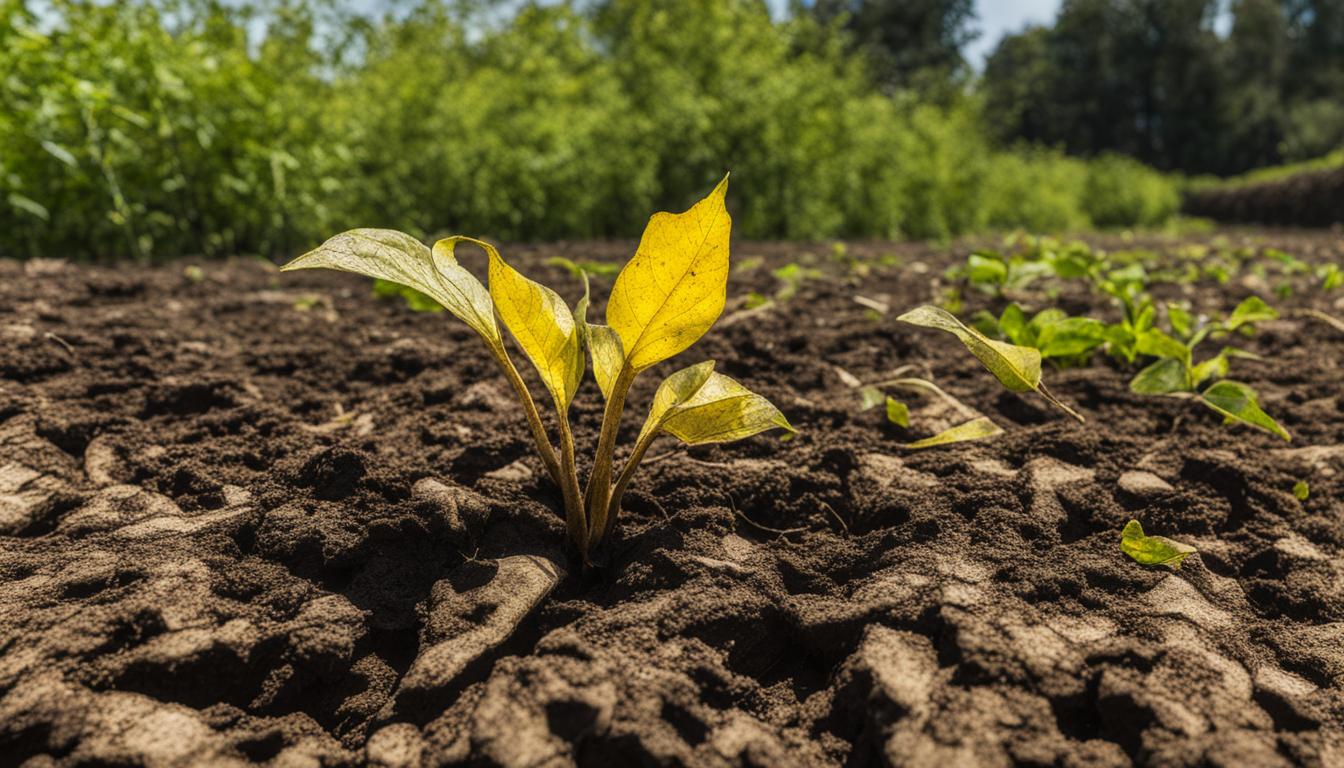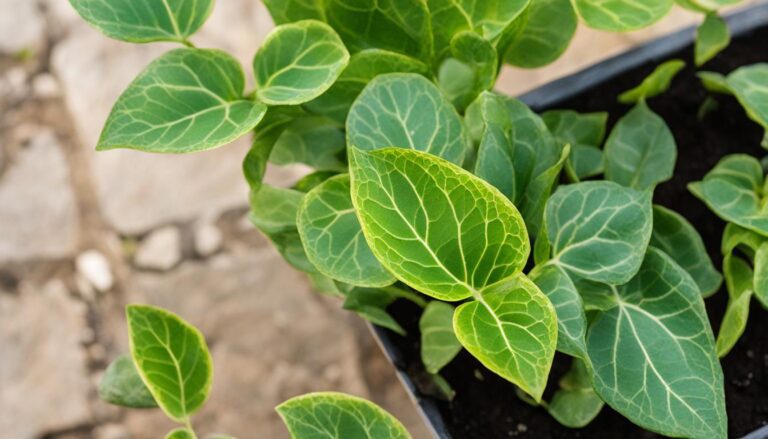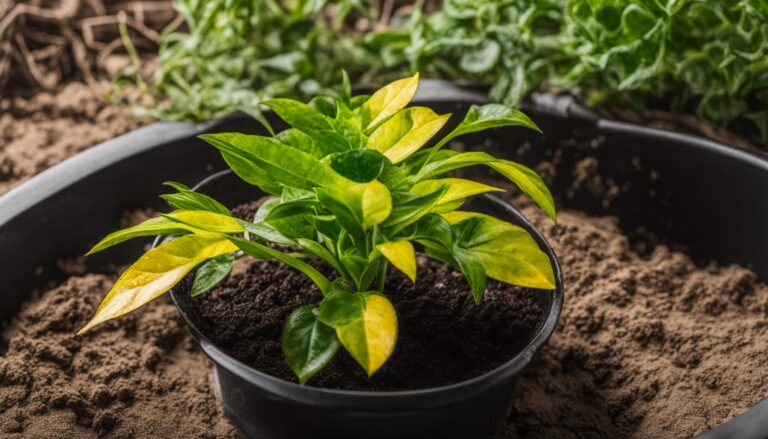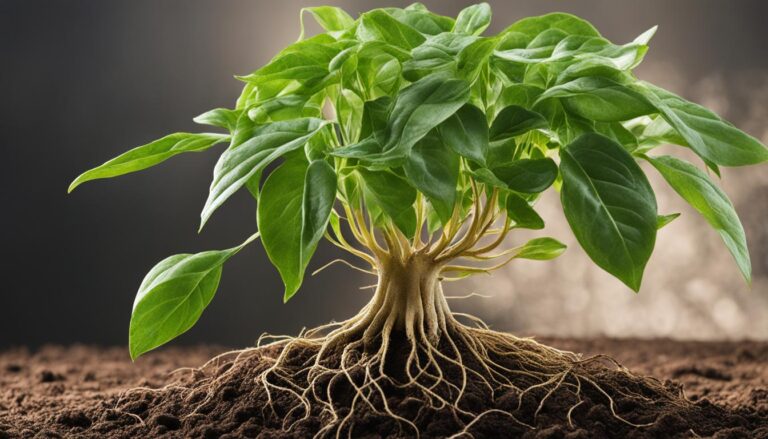
As a professional copywriting journalist, I am here to shed light on the signs and symptoms of phosphorus deficiency in plants. Phosphorus deficiency can have detrimental effects on plant health and development, so it is essential to recognize the early warning signs.
By understanding the symptoms, we can take proactive measures to address the deficiency and ensure the vitality of our plants.
Key Takeaways:
- Phosphorus deficiency in plants can be identified through various signs and symptoms.
- Young leaves in broadleaf plants may appear dark green with purplish veins.
- Older leaves can have an overall purplish tint and may experience tip dieback.
- Conifers may display discolored foliage, and new needles may not be produced in severe deficiency.
- A measurement of less than 0.1% phosphorus in current-season foliage indicates phosphorus deficiency.
Phosphorus deficiency in plants can manifest in various ways, depending on the plant species. In broadleaf plants, young leaves may exhibit a dark green color with purplish veins, particularly on the undersides of the leaves.
Older leaves might display an overall purplish tint and experience tip dieback. Additionally, leaves can become curled, distorted, smaller than usual, or even drop prematurely.
Conifers, on the other hand, may have foliage that appears discolored with a gray-green or dull blue-green hue.
In severe cases of phosphorus deficiency, older conifers may not produce new needles, indicating a significant lack of phosphorus. Seedling needles might also turn purple as a result of the deficiency.
One crucial indicator of phosphorus deficiency is a measurement of less than 0.1% phosphorus in the current-season foliage.
It is essential to compare the phosphorus levels in symptomatic plants to nearby healthy plants of the same species to get an accurate diagnosis.
Causes of Phosphorus Deficiency in Plants
Phosphorus deficiency in crops and plants lacking phosphorus can be attributed to various factors. One common cause is soil or root problems that hinder the absorption of phosphorus by the roots.
These problems can include compacted soil, poor root development, or excessive levels of other nutrients that compete with phosphorus for uptake.
In addition, certain herbicides can induce leaf distortions and curling that resemble symptoms of phosphorus deficiency. It is important to consider these factors when diagnosing and addressing phosphorus deficiency in plants.
An imbalance of nutrients in the soil can also contribute to phosphorus deficiency. If there are insufficient levels of phosphorus compared to other essential nutrients like nitrogen and potassium, plants may exhibit signs of deficiency.
Similarly, incorrect pH levels in the soil can affect phosphorus availability, as high or low pH can limit the uptake of this essential nutrient. It is crucial to maintain balanced nutrient levels and pH in the soil to prevent phosphorus deficiency in plants.
In agricultural settings, phosphorus deficiency can result from inadequate phosphorus content in the soil. This can be due to natural factors such as weathering or leaching, or it may be a result of excessive phosphorus removal through crop harvesting.
Using manure or fertilizers that do not provide sufficient phosphorus can contribute to deficiency in agricultural crops. It is essential for farmers and gardeners to monitor and replenish phosphorus levels in the soil to ensure healthy plant growth and optimal crop production.
How to Detect Phosphorus Deficiency in Plants
Detecting phosphorus deficiency in plants requires careful observation and testing. By closely monitoring the appearance of the leaves and comparing them to nearby healthy plants of the same species, you can identify key indicators of phosphorus deficiency. Here are some signs to look for:
- Dark green leaves with purplish veins
- Overall purplish tint
- Tip dieback
- Leaf curling and distortion
- Smaller leaf size
- Premature leaf drop
These visual cues can provide valuable insights into a plant’s phosphorus status. Additionally, testing the current-season foliage for phosphorus content can help confirm the deficiency.
If the foliage of symptomatic plants shows significantly lower phosphorus levels compared to healthy plants, it’s a strong indication of phosphorus deficiency.
While visual observation and testing are important tools, it’s essential to consider other factors that might contribute to the symptoms.
Some plant diseases, pests, or environmental stressors can also cause similar leaf abnormalities. Therefore, it’s crucial to rule out other potential causes before concluding that phosphorus deficiency is the primary issue.
By accurately detecting phosphorus deficiency in plants, you can take appropriate steps to address the problem and help your plants thrive. In the next section, we will explore various treatment methods for phosphorus deficiency. Stay tuned!
Treating phosphorus deficiency in plants

When treating phosphorus deficiency in plants, it is crucial to address the underlying causes and ensure that the plants receive sufficient phosphorus.
One common cause of phosphorus deficiency is soil or root problems that hinder the absorption of phosphorus by the roots. To improve phosphorus absorption, it is important to address these issues.
Adding fertilizers that contain phosphorus, such as ammonium phosphate, can help provide the necessary nutrient.
However, it is essential to be cautious when using manure as a source of phosphorus. While manure can be effective in supplying phosphorus, it often contains high salt content, which can be detrimental to plant health.
In most cases, adding phosphorus to soils in California is not recommended unless specific deficiencies have been identified.
When it comes to established woody plants, it is advisable to fertilize based on their specific needs. Complete fertilizers, which contain all three essential elements (nitrogen, phosphorus, and potassium), are generally not recommended for most landscape plants, except for certain species like palms.
It is important to tailor the fertilizer application to the individual requirements of each plant to ensure optimal growth and development.
Recommended Treatments for Phosphorus Deficiency
| Treatment Method | Description |
|---|---|
| Addressing soil or root problems | Identify and rectify any issues that hinder phosphorus absorption by the roots, such as compacted soil or root diseases. |
| Applying fertilizers | Use fertilizers containing phosphorus, such as ammonium phosphate, to provide the necessary nutrient. |
| Using manure | While manure can be effective in supplying phosphorus, be cautious of its high salt content, which can be detrimental to plant health. |
| Tailoring fertilizer application | Fertilize established woody plants based on their specific needs, using complete fertilizers as necessary. |
By addressing the causes of phosphorus deficiency and providing the plants with the necessary nutrients, it is possible to effectively treat this condition and promote healthy plant growth. It is important to consider the individual requirements of different plant species and adjust treatment methods accordingly.
The importance of phosphorus for plant growth
As a professional copywriting journalist, I cannot emphasize enough the crucial role that phosphorus plays in the growth and development of plants.
Phosphorus is one of the primary nutrients that plants need to thrive, alongside nitrogen and potassium. It is involved in various essential functions that contribute to overall plant health and vitality.
One of the key contributions of phosphorus is its role in promoting stalk strength, which is essential for supporting the weight of plants and preventing lodging.
Phosphorus is vital for seed yield and flower formation, ensuring healthy reproduction and the production of high-quality crops.
Furthermore, phosphorus is essential for root development, enabling plants to establish strong and extensive root systems. This is crucial for efficient water and nutrient uptake, as well as for anchoring plants securely in the soil.
Phosphorus also contributes to disease resistance, helping plants ward off pathogens and remain healthy throughout their life cycle.
In agricultural crops, maintaining sufficient phosphorus levels in the soil is of utmost importance. Phosphorus deficiency can have a detrimental impact on crop production and overall plant health.
By ensuring an optimal supply of phosphorus, farmers can support the growth, development, and productivity of their crops, ultimately leading to successful harvests and sustainable farming practices.
FAQ
What are the signs of phosphorus deficiency in plants?
Phosphorus deficiency in plants can be identified through various signs and symptoms. In broadleaf plants, young leaves may appear dark green with purplish veins, especially on the undersides of the leaves. Older leaves can have an overall purplish tint and may experience tip dieback. Leaves may also become curled, distorted, smaller than normal, or drop prematurely. In conifers, foliage on older trees may be discolored gray-green or dull blue-green, and with severe deficiency, few or no new needles are produced. Phosphorus-deficient seedling needles can turn purple. Another indication of phosphorus deficiency is a measurement of less than 0.1% phosphorus in current-season foliage. It is important to compare the phosphorus levels in foliage of symptomatic plants versus nearby healthy plants of the same species.
What are the causes of phosphorus deficiency in plants?
Phosphorus deficiency in plants can occur due to several factors. In some cases, it may be caused by soil or root problems that prevent roots from absorbing phosphorus effectively. Certain herbicides can also cause leaf distortion and curling that resemble phosphorus deficiency symptoms. Additionally, an imbalance of nutrients, incorrect pH levels, high iron concentration in the growing medium, or extreme cold conditions can contribute to phosphorus deficiency. In agricultural crops, phosphorus deficiency can result from inadequate phosphorus in the soil or from using manure or fertilizers that do not provide sufficient phosphorus.
How do you detect phosphorus deficiency in plants?
Detecting phosphorus deficiency in plants requires observation and testing. It is important to closely monitor the appearance of the leaves, looking for signs such as dark green leaves with purplish veins, overall purplish tint, tip dieback, curling, distortion, smaller size, and premature leaf drop. Comparison testing between symptomatic plants and nearby healthy plants of the same species can help identify phosphorus deficiency by revealing significantly lower phosphorus levels in the foliage of symptomatic plants. Testing current-season foliage for phosphorus content is also a useful method to determine phosphorus deficiency.
How is phosphorus deficiency in plants treated?
Treating phosphorus deficiency in plants involves addressing the underlying causes and providing the plants with sufficient phosphorus. If the deficiency is due to soil or root problems, it is important to address these issues to improve phosphorus absorption. In some cases, adding a fertilizer such as ammonium phosphate or using chicken manure can help provide phosphorus. However, it is important to be cautious with manure due to its high salt content. In general, adding phosphorus to most soils in California is rarely beneficial for landscape plants, as the soil is rarely deficient in all three essential elements (nitrogen, phosphorus, and potassium). Fertilizing established woody plants should be done based on specific needs, and complete fertilizers are generally not recommended except for certain plants like palms.
Why is phosphorus important for plant growth?
Phosphorus is an essential nutrient for plant growth and plays a crucial role in various aspects of plant development. It is one of the primary nutrients required by plants, along with nitrogen and potassium. Phosphorus is involved in promoting stalk strength, seed yield, flower formation, root development, disease resistance, and overall crop quality. Adequate phosphorus levels in the soil are necessary for the proper growth and vitality of plants. In agricultural crops, maintaining sufficient phosphorus levels is particularly important to ensure optimal crop production and development throughout the plant’s life cycle.







One Comment
Comments are closed.